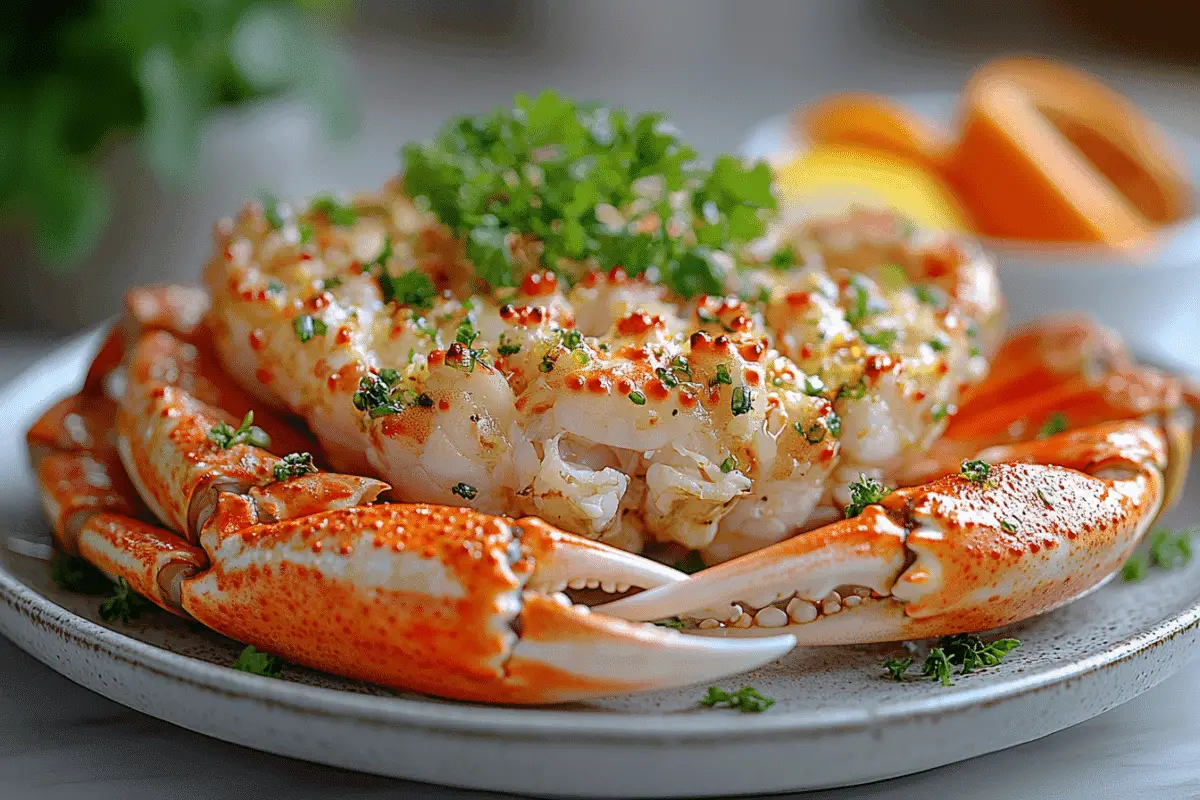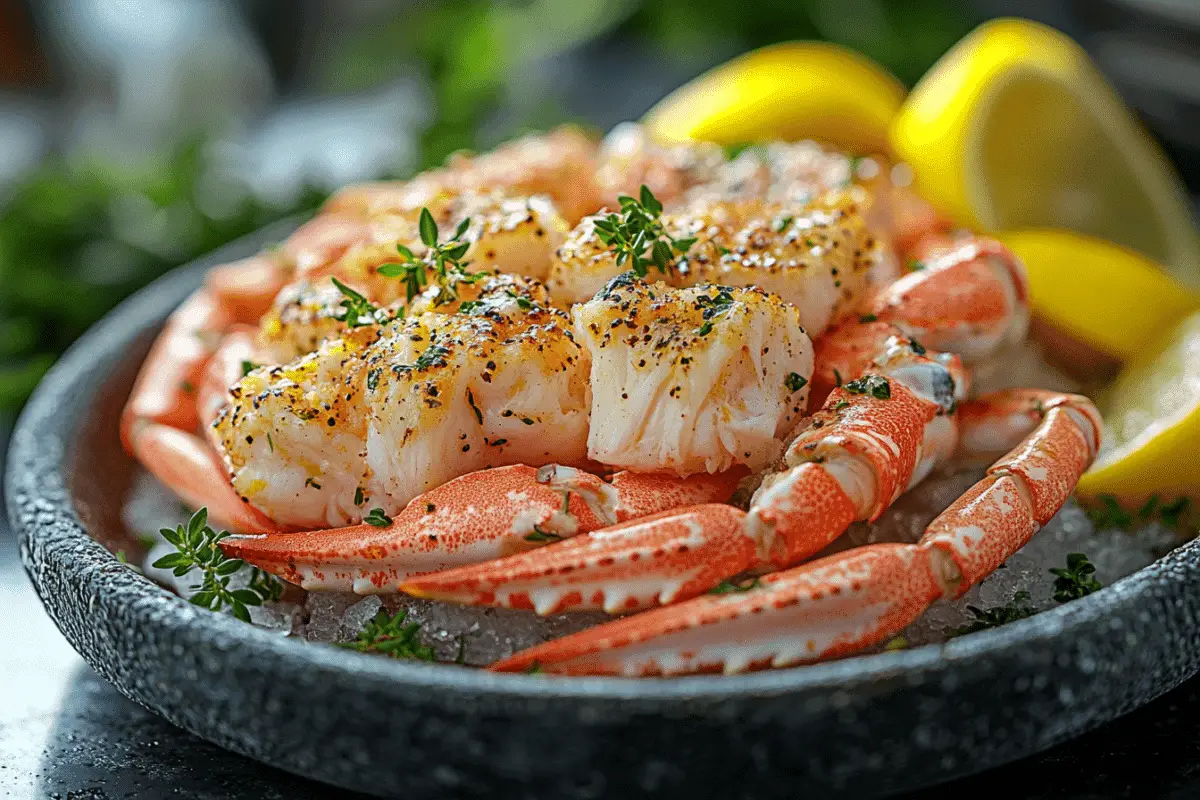
Snow crab is a popular seafood delicacy known for its sweet, tender meat and versatility in cooking. Found mainly in the cold waters of the North Atlantic and North Pacific Oceans, this crab species has become a staple in many kitchens and restaurants worldwide. Whether you’re curious about its culinary uses, health benefits, or sustainability, this guide will cover everything you need to know about crab.
Introduction
Spider crab thrives in cold ocean waters. With its long, spindly legs and sweet, delicate meat, it quickly became a favorite among seafood lovers. You’ll often find Spider crab on menus featuring crab legs, crab cakes, and other delicious dishes. Because it is widely available and tasty, people in many parts of the world enjoy consuming crab. Moreover, its versatility makes it suitable for various culinary applications.
Although some people compare Spider crab to other crabs, such as king crab, Spider crab stands out due to its distinct texture and flavor. Furthermore, it offers a lighter taste, which many prefer. For a deeper understanding, you can explore the differences between crab and other types of crabs through the NOAA Fisheries guide on Spider crab.
Where Are they Found
Snow crabs typically live in the frigid waters of the North Atlantic and North Pacific Oceans. They thrive in deep, cold environments, often in the Bering Sea and around the coastlines of Alaska and Canada. The harsh conditions in these regions significantly contribute to the unique texture and taste of Spider crab meat. Additionally, the cold water enhances the flavor, making it a preferred choice for many seafood enthusiasts.
Fishermen catch these crabs using special traps or pots, which ensures minimal environmental impact. Consequently, sustainable fishing practices remain crucial, especially as environmental changes and overfishing continue to challenge Spider crab populations. To learn more about these challenges, you can explore the snow crab population decline discussed by The Food Institute.
How to Cook Snow Crab
Cooking Spider crab is simple, yet the results are incredibly delicious. Here’s a basic guide to preparing Spider crab:
1. Boiling Crab
- Then, add a generous amount of salt and any spices you prefer.
- Submerge the Spidercrab legs in the boiling water and cook them for about 5-7 minutes.
- Finally, remove the legs and let them drain before serving. This method is quick and preserves the delicate flavors.
2. Steaming Crab
- Arrange the crab legs in the basket.
- Cover and steam them for about 5 minutes until the crab heats through. Steaming, moreover, retains moisture and enhances the natural sweetness of the crab.
3. Baking Snow Crab
- Preheat your oven to 350°F (175°C).
- Arrange the Spider crab legs on a baking sheet and brush them with melted butter.
- Bake them for 7-10 minutes, until the meat becomes warm and fragrant.
Popular Snow Crab Recipes
crab is incredibly versatile, and there are many ways to enjoy it. Some popular dishes include:
- Crab Cakes: Mix Spider crab meat with breadcrumbs, eggs, and seasonings, then pan-fry until golden brown. This dish, for example, highlights the crab’s flavor with a crispy exterior.
- Crab Salad: Combine Spider crab meat with fresh vegetables and a light dressing for a refreshing dish. Additionally, it offers a lighter, healthier way to enjoy crab.
- Crab Legs with Garlic Butter: Serve boiled or steamed crab legs with melted garlic butter for dipping. The garlic butter, moreover, complements the sweet meat perfectly.
If you’re interested in exploring different seafood dishes, you can also want to check out this gluten-free crab cake recipe for a delicious and healthy option.
Nutritional Value
Crab is not only tasty but also nutritious. A typical serving of crab provides:
- High Protein: Spider crab serves as a great source of protein, which is essential for muscle growth and repair. Furthermore, it offers all the essential amino acids your body needs.

Health Benefits
Eating snow crab offers several health benefits, such as:
- Supports Immune Function: The high levels of zinc in Spider crab help boost the immune system. As a result, regularly consuming crab can contribute to better overall health.
- Promotes Healthy Skin: Selenium in Spider crab acts as an antioxidant, protecting skin cells from damage. Consequently, it helps maintain youthful skin.
- Aids in Muscle Recovery: The protein content in crab supports muscle recovery after physical activity. Additionally, it provides the necessary nutrients for muscle repair and growth.
If you’re also focused on healthy eating, consider trying some gluten-free breakfast ideas to start your day off right.
The Global Market
The Spider crab market has seen significant growth in recent years, driven by increasing demand from consumers around the world. Major markets for Spidercrab include the United States, Canada, and Japan, where people prize it for its flavor and versatility. Seasonal availability and factors such as environmental conditions often influence the price and availability of Spider crab. Therefore, understanding these market dynamics can help you make informed purchasing decisions.
FAQs
What is the difference between snow crab and king crab?
Spider crab legs are thinner and have a sweeter taste compared to the meatier legs of king crab. Therefore, many prefer Spider crab for its delicate flavor.
Why is snow crab more affordable than other types of crab?
Spider crab often costs less because it’s more abundant and easier to harvest than other crabs like king crab. As a result, it’s a popular choice for budget-conscious consumers.
How can you tell if Spider crab is fresh?
You can tell Spider crab is fresh if it has a slightly sweet, ocean-like smell and firm, white meat. Moreover, fresh crab should not have any fishy odor.
Can snow crab be eaten raw?
Although some seafood can be eaten raw, people usually cook crab to enhance its flavor and ensure safety. Cooking, additionally, brings out the crab’s natural sweetness.
What is the best way to store leftover Spider crab?
Store leftover Spider crab in an airtight container in the refrigerator, and consume it within two days for the best taste. Proper storage, moreover, helps maintain its texture and flavor.
Snow Crab Sustainability and Environmental Practices
Ensuring the sustainability of crab populations is crucial for maintaining ecological balance and supporting the fishing industry. Organizations like NOAA and the Marine Stewardship Council (MSC) have developed guidelines to promote sustainable fishing practices. These include setting quotas, monitoring crab populations, and using crab pots to minimize bycatch. By choosing crab certified by sustainability programs, consumers can help protect marine ecosystems and ensure that future generations can enjoy this seafood delicacy.
In addition, some regions are adopting innovative techniques, such as rotational fishing zones, to allow crab populations to replenish naturally. These efforts highlight the importance of sustainable seafood consumption in preserving our oceans.
The Best Dipping Sauces for Snow Crab
Pairing crab with the right dipping sauce elevates the dining experience. Here are some classic and creative options:
- Garlic Butter Sauce: A timeless choice that enhances the natural sweetness of snow crab meat.
- Lemon Herb Aioli: Combining fresh lemon juice, parsley, and mayonnaise, this sauce adds a zesty kick.
- Spicy Cajun Dip: Made with hot sauce, paprika, and a hint of garlic, this dip is perfect for spice lovers.
- Honey Mustard Sauce: A blend of honey and Dijon mustard offers a sweet and tangy flavor.
- Creamy Dill Sauce: Mix sour cream, fresh dill, and a touch of lemon juice for a refreshing accompaniment.
Experimenting with different sauces allows you to customize your snow crab dish to suit any occasion or palate.
Snow Crab in Global Cuisines
While snow crab is often associated with North American seafood boils, it is also a beloved ingredient in various global cuisines:
- Japanese Cuisine: Snow crab is featured in sushi rolls, tempura, and miso soups, where its sweet flavor complements other umami-rich ingredients.
- Korean Cuisine: Known as “daege,” snow crab is often used in spicy stews or marinated dishes like ganjang-gejang.
- Mediterranean Cuisine: Snow crab is added to pasta dishes or served with olive oil, garlic, and fresh herbs for a simple yet elegant meal.
- Caribbean Cuisine: Incorporating snow crab into tropical dishes with coconut milk, chili peppers, and lime creates a bold fusion of flavors.
These international recipes demonstrate the versatility of snow crab, making it a culinary favorite worldwide.
How to Crack Snow Crab Legs Like a Pro
Enjoying snow crab often involves cracking its legs to access the tender meat inside. Here’s a foolproof guide:
- Snap the Joints: Gently bend the legs at the joints to separate them into smaller sections.
- Use Scissors: Kitchen scissors are ideal for cutting through the shell. Make a clean cut along the length of the leg.
- Remove the Meat: Slide a small fork or your fingers inside the shell to extract the meat in one piece.
- Dip and Enjoy: Pair the meat with your favorite sauce for maximum flavor.
Mastering this technique not only enhances your dining experience but also ensures you make the most of every bite.
Health Benefits of Regularly Consuming Snow Crab
Including snow crab in your diet offers numerous health advantages:
- Heart Health: The omega-3 fatty acids in snow crab help reduce inflammation and support cardiovascular health.
- Weight Management: Low in calories and fat, snow crab is an excellent protein source for those looking to maintain or lose weight.
- Brain Function: High levels of selenium and vitamin B12 support cognitive health and protect against age-related memory decline.
- Bone Strength: The calcium and magnesium in snow crab contribute to healthy bones and teeth.
By incorporating snow crab into your meals, you can enjoy its delicious flavor while reaping these nutritional benefits.
How to Buy Snow Crab: Fresh vs. Frozen
When purchasing snow crab, you’ll often have the option of fresh or frozen. Here’s how to decide:
- Fresh Snow Crab: Ideal for immediate consumption, fresh crab has a superior taste and texture. Look for legs with a bright color and no fishy odor.
- Frozen Snow Crab: A convenient option, frozen crab retains its flavor and nutritional value when properly stored. Choose vacuum-sealed packages to avoid freezer burn.
Both options have their merits, so consider your cooking timeline and preferences when making your choice.
Snow Crab Pairings for a Complete Meal
Enhance your snow crab meal by pairing it with complementary dishes:
- Side Dishes: Garlic mashed potatoes, roasted asparagus, or a simple green salad.
- Beverages: A crisp white wine like Sauvignon Blanc, a refreshing lager, or sparkling water with citrus.
- Desserts: Lemon sorbet, cheesecake, or fruit tarts provide a sweet ending to a seafood feast.
These pairings elevate snow crab from a main course to a memorable dining experience.
Snow Crab’s Role in Holiday Feasts
Snow crab is a luxurious addition to holiday celebrations, offering a unique alternative to traditional main courses. Whether served as an appetizer, part of a seafood platter, or the centerpiece of a festive dinner, snow crab impresses guests with its delicate flavor and elegant presentation. To make your holiday meal even more special, consider serving snow crab alongside lobster tails, shrimp cocktails, and a selection of fine wines.
FAQs: How to Reheat Snow Crab
Leftover snow crab can be just as delicious when reheated correctly.
- Steaming: Place the crab legs in a steamer basket over boiling water for 3-5 minutes.
- Oven Method: Wrap the crab legs in aluminum foil with a splash of water and bake at 350°F (175°C) for 10 minutes.
- Microwave: Cover the crab legs with a damp paper towel and heat in 30-second intervals until warm.
These methods ensure your snow crab remains moist and flavorful, even the second time around.
Snow Crab’s Contribution to Coastal Communities
The snow crab industry is a vital part of many coastal economies, providing jobs for fishermen, processors, and restaurant workers. Beyond its economic impact, the industry supports cultural traditions, such as seafood festivals and community events centered around crab harvests. By purchasing snow crab from local suppliers, consumers can help sustain these communities while enjoying a delicious and responsibly sourced product.
Conclusion
Snow crab is a delicious and versatile seafood option that many people around the world enjoy. Whether you’re boiling, steaming, or baking it, Spider crab offers a satisfying meal that’s both nutritious and flavorful. With more knowledge about its preparation, nutritional benefits, and market availability, you can appreciate this delicacy even more.
